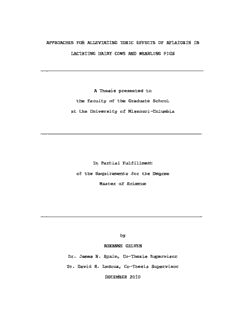
APPROACHES FOR ALLEVIATING TOXIC EFFECTS OF AFLATOXIN IN LACTATING DAIRY ... PDF
Preview APPROACHES FOR ALLEVIATING TOXIC EFFECTS OF AFLATOXIN IN LACTATING DAIRY ...
APPROACHES FOR ALLEVIATING TOXIC EFFECTS OF AFLATOXIN IN LACTATING DAIRY COWS AND WEANLING PIGS _______________________________________________________ A Thesis presented to the Faculty of the Graduate School at the University of Missouri-Columbia ___________________________________________________________ In Partial Fulfillment of the Requirements for the Degree Master of Science ___________________________________________________________ by ROXANNE GELVEN Dr. James N. Spain, Co-Thesis Supervisor Dr. David R. Ledoux, Co-Thesis Supervisor DECEMBER 2010 The undersigned, appointed by the Dean of the Graduate School, have examined the thesis entitled: APPROACHES FOR ALLEVIATING TOXIC EFFECTS OF AFLATOXIN IN LACTATING DAIRY COWS AND WEANLING PIGS presented by Roxanne Gelven a candidate for Master of Science and hereby certify that, in their opinion, it is worthy of acceptance. _____________________________________ Dr. James Spain _____________________________________ Dr. David Ledoux _____________________________________ Dr. George Rottinghaus _____________________________________ Dr. Mark Ellersieck ACKNOWLEDGEMENTS I would like to express my sincere appreciation and gratitude to my advisor, Dr. James Spain for his continuous support, encouragement, direction, giving me knowledge about dairy cattle production, and guidance throughout my masters training. I also wish to express my appreciation and deep gratitude to my other advisor, Dr. David Ledoux for giving me a job in his lab, knowledge about mycotoxins, vitamins and minerals, and for guidance throughout the preparation of this thesis. Without his guidance and constructive comments this thesis could not have been completed. I wish to express my appreciation and special thanks to my graduate committee, Dr. George Rottinghaus for giving me knowledge about mycotoxin preparation and analysis, and Dr. Mark Ellersieck for statistical analysis guidance. Without teaching and guidance from my graduate committee this thesis could not have been completed. ii Special thanks are given to all of the students in Lab 112. It has been amazing working with all of you the past 4½ years. Thanks for all of the support and friendship you have given me! I especially would like to express gratitude to my family and friends for all of their love and support for me during my pursuit of a master of science degree. Above all, I would like to thank my husband, Travis Gelven, for his love, help, and patience and understanding during my studies here at MU. iii TABLE OF CONTENTS ACKNOWLEDGEMENTS………………………………………………………………………………………………………….ii LIST OF TABLES…………………………………………………………………………………………………………….vii Chapter 1. LITERATURE REVIEW: Introduction……………………………………………………………………………………………………………1 Aflatoxin……………………………………………………………………………………………………………………2 Aflatoxin and Dairy Cattle………………………………………………………………………5 Aflatoxin and Swine………………………………………………………………………………………10 Adsorbents………………………………………………………………………………………………………………15 Antioxidants…………………………………………………………………………………………………………21 2. EFFICACY OF SOLIS, NOVASILPLUS, AND MTB-100 TO REDUCE AFLATOXIN M1 LEVELS IN MILK OF EARLY TO MID LACTATION DAIRY COWS FED AFLATOXIN B1….……………………………………………………………………26 iv Abstract……………………………………………………………………………………………………………………26 Introduction……………………………………………………………………………………………………….28 Materials and Methods…………………………………………………………………………………30 Experimental Procedures………………………………………………………………….30 Analytical Procedures…….…………………………………………………………………33 Statistical Procedures………………………………………………………………………34 Results and Discussion……………………………………….……………………………………35 Conclusions……………………………………………………………………………………………………………40 CURCUMA LONGA 3. EFFICACY OF CURCUMINOIDS FROM TURMERIC ( ) POWDER IN REDUCING THE TOXIC EFFECTS OF AFLATOXIN B1 IN WEANLING PIGS….……………………………………………………………………………………………….44 Abstract……………………………………………………………………………………………………………..44 Introduction………………………………………………………………………………………………………47 Materials and Methods…….………………………………………………………………………48 Experimental Procedures……………………………………………………………………48 Analytical Procedures…………………………………………………………………………49 Statistical Analysis……………………………………………………………………………51 v Results……………………………………………………………………………………………………………………52 Discussion……………………………………………………………………………………………………………54 Conclusions…………………………………………………………………………………………………………59 4. GENERAL SUMMARY AND CONCLUSIONS……………………………………………………………67 5. LITERATURE CITED……………………………………………………………………………………………………71 vi LIST OF TABLES Table Page 2.1 Ingredient and nutrient composition of lactating cow diet…………………………………………………………….………………….41 2.2 Effects of dietary treatments on milk production and composition by dairy cows fed 112 µg of AFB1/kg of Dry Matter Intake……………….…………………………………….42 2.3 Efficacy of adsorbents in reducing aflatoxin M1 (AFM1) residues in milk of dairy cows fed 112 µg of AFB1/kg of Dry Matter Intake……………………………………………….43 3.1 Ingredient and nutrient composition of Phase 2 nursery diet (as-fed).…………………………………………………………………………61 3.2 Effects of AFB1 on growth performance and organ vii weights of weanling pigs.…………………………………………………………………62 3.3 Effects of AFB1 on blood serum chemistry of weanling pigs…..……………………………………………………………………………………….63 3.4 Effects of AFB1 on hematology of weanling pigs…………….64 3.5 Effects of AFB1 on liver histopathology of weanling pigs.…………………………………………………………………………………………….65 3.6 Effects of AFB1 on kidney histopathology of weanling pigs.………………………………………………………………………………………………66 viii CHAPTER 1 LITERATURE REVIEW Introduction Mycotoxins are produced as secondary metabolites by molds. With respect to human and animal diseases there are Aspergillus, Penicillium, primarily three genera of fungi; and Fusarium that are of concern. Molds that produce mycotoxins are extremely common and can grow on a wide range of substrates under a wide range of environmental conditions. The major classes of mycotoxins that pose the greatest potential risk to human and animal health as food and feed contaminants are aflatoxins, trichothecenes, fumonisins, zearalenone, ochratoxin A, and the ergot alkaloids. Contamination with mycotoxins often begins in the field and increases during harvest, drying, and storage (Cast, 2003). Two primary factors influencing mycotoxin production both pre-harvest and post-harvest are temperature and moisture. The potential economic costs of crop losses from mycotoxins in the United States are on 1
Description: